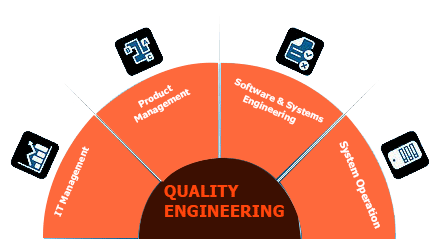
Why Quality Assurance is Shifting to Quality Engineering? (Explained)
December 3rd, 2023

Table of Contents
1. What is Quality Engineering?
2. What are Quality Assurance and Quality Engineering?
3. The Overall Culture is Changing Along With the Market Expansion
4. The Drawback of the old Working Style
5. Why this Change is Essential
6. How this is Beneficial to the Software Development Community
Software Quality Assurance (SQA) encapsulates the methodologies and tools essential for monitoring and ensuring the quality of software products. Developers carried out manual checks as the final step in the development cycle in the early stages of software development, which was primarily their responsibility.
Yet, as software development complexities burgeon and the market landscape expands, this conventional approach encounters limitations.
However, there is a solution.
What is Quality Engineering?
Quality Engineering (QE) is a systematic and disciplined approach to ensuring the reliability, efficiency, and functionality of software systems throughout the development lifecycle. It involves the application of engineering principles to design, implement, and maintain testing processes and methodologies.
Quality Engineers employ rigorous testing techniques, automation, and continuous integration to identify defects, optimize system performance, and enhance overall software quality.
QE discipline integrates seamlessly with agile methodologies, emphasizing early defect detection, efficient test automation, and continuous improvement, ultimately delivering robust software solutions that meet or exceed predefined quality standards.
What are Quality Assurance and Quality Engineering? (Differences Explained!)
Quality Assurance (QA) and Quality Engineering (QE) are integral components of the software development lifecycle, each playing distinct roles in ensuring the delivery of high-quality software products. While QA is a broader concept encompassing the entire development process, QE is a specialized discipline within QA focusing on engineering practices for optimal quality outcomes.
Quality Assurance (QA):
QA is a comprehensive approach that involves the entire software development lifecycle. It encompasses processes, methodologies, and activities aimed at preventing defects and ensuring that the final product meets specified requirements. QA is a proactive strategy that involves:
- Defining Processes: Establishing guidelines, standards, and methodologies for the entire development team.
- Process Compliance: Ensuring adherence to defined processes throughout the development lifecycle.
- Audits and Reviews: Conducting audits and reviews to identify deviations from established processes.
Quality Engineering (QE):
QE is a subset of QA that specifically focuses on engineering practices to achieve desired quality outcomes. It involves applying engineering principles to testing and validation processes, emphasizing automation, efficiency, and continuous improvement. Key aspects of QE include:
- Test Automation: Developing automated test scripts to enhance testing efficiency and coverage.
- Performance Engineering: Optimizing software performance through load testing and analysis.
- Continuous Improvement: Iteratively refining processes based on testing outcomes and feedback.
Differences Between QA and QE:
| Criteria | Quality Assurance (QA) | Quality Engineering (QE) |
|---|---|---|
| Scope | Broader, covering the entire software development lifecycle. | Specialized, focusing on engineering practices within QA. |
| Objective | Ensuring adherence to defined processes and standards. | Enhancing testing processes, automation, and continuous improvement. |
| Activities | Process definition, compliance monitoring, audits, and reviews. | Test automation, performance engineering, and continuous improvement. |
| Focus | Process-centric, ensuring the right processes are followed. | Outcome-centric, emphasizing optimal testing practices and efficiency. |
| Timing | Applied throughout the software development lifecycle. | Primarily during the testing phase, but influences the entire lifecycle. |
The Overall Culture is Changing Along With the Market Expansion
As the overall culture undergoes a transformative shift and markets expand, the adoption of Quality Engineering (QE) emerges as the best option for ensuring the success and sustainability of software solutions. Several factors contribute to the compelling rationale behind choosing QE as a cornerstone in this evolving landscape:
- Agile Compatibility:
- QE seamlessly integrates with Agile methodologies, aligning with the dynamic and iterative nature of modern software development. It enables continuous testing and quality checks throughout the development lifecycle, fostering quicker releases and responsiveness to changing market demands.
- Enhanced Time-to-Market:
- The fast-paced market expansion demands accelerated development cycles. QE, with its emphasis on test automation and efficient testing practices, significantly reduces time-to-market. This agility is crucial for staying ahead of competitors and swiftly adapting to evolving customer needs.
- Cost Efficiency:
- Traditional methods of software testing can be resource-intensive and costly. QE optimizes resources through test automation, allowing repetitive tests to be executed efficiently. This not only reduces testing costs but also enhances the overall cost efficiency of the software development process.
- Improved Customer Experience:
- QE ensures that software products meet or exceed customer expectations by identifying and rectifying defects early in the development process. This results in more reliable and user-friendly products, enhancing the overall customer experience and satisfaction.
- Continuous Improvement:
- The culture shift towards continuous improvement aligns with QE principles. Through continuous testing, feedback loops, and data-driven insights, QE facilitates an environment of ongoing enhancement. This adaptability is vital in an environment where market dynamics and user preferences are in constant flux.
- Risk Mitigation:
- In an expanding market, the risks associated with software defects and failures are amplified. QE, with its comprehensive testing practices, mitigates these risks by identifying potential issues early in the development cycle. This proactive approach protects the brand reputation and ensures a smoother market entry.
- Scalability and Flexibility:
- QE strategies are designed to scale seamlessly, accommodating the increased complexity and demands of an expanding market. The flexibility of QE allows teams to adjust testing approaches based on the specific requirements of diverse projects and market segments.
The Drawback Of The Old Water-fall Model
1. Lack of flexibility: The waterfall model is a rigid and linear approach to software development, which means that it is not well-suited for projects with changing or uncertain requirements. Once a phase is completed, it is difficult to go back and make changes. This can lead to problems if the requirements change or if there are bugs that were not caught in the earlier phases.
2. No working software is produced until late during the life cycle: In the waterfall model, software is not tested until the end of the development cycle. This means that there is no way to get feedback from users or to identify and fix bugs early on. This can lead to delays in the project and to software that is not what the users want or need.
3. High amounts of risk and uncertainty: The waterfall model is a risky approach to software development because there is no way to mitigate the risks of requirements changes, bugs, or other problems until late in the project. This can lead to costly delays and rework.
4. Limited user involvement: In the waterfall model, users are not involved in the development process until the testing phase. This means that their feedback is not taken into account until it is too late to make changes. This can lead to software that does not meet the needs of the users.
5. Poor communication and collaboration: The waterfall model can lead to poor communication and collaboration between different teams involved in the development process. This is because there is no opportunity for teams to share information and work together to solve problems.
6. Does not accommodate iterative development: The waterfall model is not well-suited for iterative development, where software is released in small increments and then improved based on user feedback. This is because the waterfall model requires that all requirements be known upfront, which is not possible with iterative development.
7. Does not capture emerging requirements: The waterfall model does not allow for the capturing of emerging requirements, which are requirements that are not known upfront but that become known as the project progresses. This can lead to problems if the requirements change significantly after the initial requirements have been defined.
8. Can lead to scope creep: Scope creep is when the scope of a project increases beyond what was originally agreed upon. This can happen in the waterfall model because there is no opportunity to get feedback from users or to identify and fix bugs early on. As a result, changes may need to be made late in the project, which can increase the cost and schedule of the project.
All these bottlenecks have resulted in the redefining of the role of quality analysis and culminated in the birth of quality engineering.
Why this Change is Essential
The imperative shift from Quality Assurance (QA) to Quality Engineering (QE) is propelled by the evolution of services rooted in architectural models. The paradigm shift sees teams independently defining their business implementations as a network of connected but independently governed services constrained by strict contractual protocols. This transformation necessitates a fundamental change in the approach to testing for QA engineers.
In this new landscape, QA engineers grapple with writing code even before its existence, engaging post-design to identify core functionalities for required tests. The adoption of frameworks mimicking dependencies allows teams to work seamlessly without waiting for upstream and downstream dependencies, expediting the development process.
How this is Beneficial to the Software Development
This transformative approach has reshaped the role of software developers, empowering them to not only build infrastructure but also take charge of identifying test scopes, mitigating risks, and defining quality criteria across the entire spectrum, from individual units to the final acceptance of testing and planning. This modern role is now coined as a “Software Developer in Test” (SDET).
The increased recognition and pay that these professionals now receive underscores the shift toward SDETs in addition to the evolution of duties. SDETs are being remunerated at levels commensurate with traditional developers, acknowledging the critical nature of their contributions.
Moreover, companies increasingly recognize the invaluable role of Quality Engineers in the software development process. Their impact is not merely seen as a cost but as an investment in delivering high-quality, reliable software. This paradigm shift not only elevates the status of Quality Engineers but also signifies a strategic move by companies to prioritize quality assurance as an integral part of the development lifecycle.
By integrating Quality Engineers seamlessly into the development process, organizations benefit from enhanced collaboration, faster release cycles, and a proactive approach to quality. SDETs contribute not only to testing but also to the overall improvement of development practices, ensuring that quality is not an afterthought but an inherent aspect of the software creation process. The resulting synergy between developers and Quality Engineers not only fosters a culture of quality but also propels software development towards higher efficiency and customer satisfaction.
Conclusion
As we navigate the ever-evolving landscape of software development, the role of quality engineering has transformed from mere assurance to a cornerstone of the development process. The construction of robust test-key infrastructure is paramount, enabling effortless data capture, comprehensive analysis, and actionable insights that guide effective mitigation strategies.
Quality engineering is rapidly emerging as a specialized field, demanding a unique blend of expertise that seamlessly integrates with data science.
This convergence empowers quality engineers to harness the power of data, driving informed decisions and propelling software development toward unprecedented levels of excellence.


 Software Testing Events
Software Testing Events App Testing
App Testing Web App Testing
Web App Testing Game Testing
Game Testing Automation Testing
Automation Testing Load Testing
Load Testing Security Testing
Security Testing Performance Testing
Performance Testing Hire a Tester
Hire a Tester






